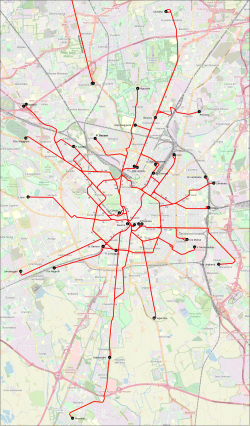Trams in Milan
 |
|||||||||||||||||||||
| Operation | |||||||||||||||||||||
|---|---|---|---|---|---|---|---|---|---|---|---|---|---|---|---|---|---|---|---|---|---|
| Locale | Milan, Italy | ||||||||||||||||||||
|
|||||||||||||||||||||
|
|||||||||||||||||||||
The Milan tramway network (Italian: Rete tranviaria di Milano) is an important part of the public transport network of Milan, Italy.
In operation since 1881, the network is now 170 kilometers (110 mi) long. It has the unusual track gauge of 1,445 mm (4 ft 8 7⁄8 in) (Italian gauge), and comprises 18 urban lines and two interurban lines. As opposed to Milan's Metro system, where no more than two lines ever cross each other at any of the interchange stations, the Milan tram system is substantially centralized, with around half of the tram lines passing by, or terminating by the side or nearby, the Piazza del Duomo at the center of Milan.
Following the establishment of omnibus services in 1841, Milan acquired its first trams on 8 July 1876, upon the inauguration of the Milan–Monza tramway, which was operated by animal traction. The terminus of this line was at Porta Venezia, outside the city limits.
On 24 June 1877, a second tramway was opened between Milan and Saronno, with a terminus at Arco della Pace.
After only a few months, the city government agreed to the laying of rails in the city. The line from Monza was therefore extended up to Piazza San Babila, and the line from Saronno through Piazza d'Armi to Via Cusani, inside the city limits.
A year later, on 6 June 1878, Milan's first steam tramway, to Vaprio, started operations. The success of this line made steam power popular. The existing line to Saronno was therefore extended (1878), and new lines were constructed to Sedriano (1879), Vimercate, Pavia and Lodi (1880), Giussano (1881), and elsewhere. These lines did not form a single network, but were awarded to different companies, and were operated from different termini.
...
Wikipedia

